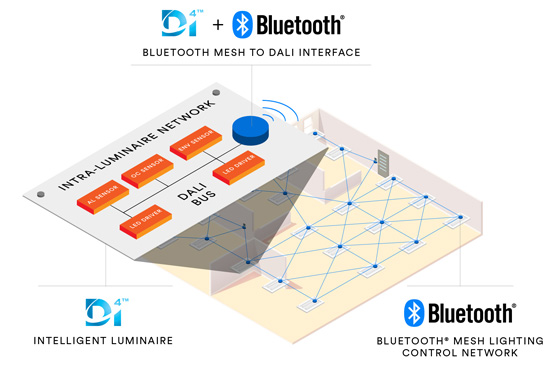Bluetooth and Dali combine for IoT commercial lighting
- June 9, 2020
- imc

The Bluetooth Special Interest Group (SIG) and the DiiA, the Dali alliance of companies from the lighting and sensor industries, are collaborating to accelerate the adoption of IoT-enabled commercial lighting.
The collaboration will enable the deployment of certified Dali-2 devices and intelligent D4i luminaires with qualified Bluetooth mesh intelligent lighting-control networks. This collaboration brings together two complementary IoT standards for commercial lighting.
“Combining Bluetooth mesh with Dali is a natural choice for the commercial lighting industry,” says Paul Drosihn, DiiA general manager. “The combination enables sensor-rich lighting systems and will deliver powerful new IoT capabilities to building managers. This will include automated light-level and colour control, advanced luminaire performance monitoring including energy usage and predictive maintenance, as well as enhanced services such as asset tracking and indoor navigation.”
IoT-enabled commercial lighting systems are comprised of two key components: IoT-enabled luminaires that include sensors and other devices, and an IoT-enabled lighting control system. Dali-2 from the DiiA provides an ecosystem of certified lighting devices including intelligent D4i luminaires. Bluetooth mesh, from the Bluetooth SIG, is an IoT standard for intelligent wireless lighting-control networks.
“Commercial building owners around the world are being asked to improve energy efficiency while also enhancing the occupant experience,” said Mark Powell, CEO of the Bluetooth SIG. “The IoT-enabled intelligent lighting systems this collaboration enables promise to deliver the exact solution these building owners need.”
Through this collaboration, lighting-industry companies from both organisations are bringing these two standards together by specifying a standard Bluetooth mesh interface for certified Dali-2 and D4i devices, enabling connectivity with qualified Bluetooth mesh lighting-control networks.
“We are excited to support this collaboration between the Bluetooth SIG and DiiA,” said Arnulf Rupp, head of standardisation at Osram. “Establishing a standard Bluetooth mesh interface for D4i intelligent luminaries will open up industry opportunity and enable the deployment of even more advanced, interoperable IoT-enabled commercial lighting systems, while ensuring an equivalent light control behaviour between both standards.”
To help streamline the delivery of products to market, the Bluetooth SIG and DiiA are also working together to make it easier for vendors to complete both the Bluetooth product qualification and Dali-2 product certification processes necessary to ensure interoperability. In turn, this will ensure that Bluetooth mesh lighting control, combined with certified Dali-2 and D4i devices, remains a natural choice for the professional lighting industry.
The image shows one specific implementation of Dali-Bluetooth gateways. Here, a single room contains a network of D4i luminaires connected by Bluetooth mesh. Lighting control is achieved via the intra-luminaire Dali bus, making use of data from on-board sensors (AL = ambient light, OC = occupancy, ENV = environmental). Meanwhile the D4i LED drivers can store and report a standardised data set – luminaire, energy and diagnostics data – that is available via the Bluetooth mesh network to a connected building management system.
Formed in 1998, the Bluetooth SIG is the not-for-profit trade association that oversees Bluetooth technology. In support of more than 35,000 member companies, the Bluetooth SIG facilitates the collaboration of its members to create specifications that expand the technology, drive global interoperability via a product qualification programme and grow the brand by increasing the awareness, understanding and adoption of Bluetooth technology.
Bluetooth mesh is the mesh networking capability of Bluetooth technology. Designed for large-scale device networks, Bluetooth mesh enables thousands of devices to communicate securely with one another.
The Digital Illumination Interface Alliance (DiiA) is an open consortium of lighting companies that aims to grow the market for lighting-control based on Dali technology.
• ICT association Bicsi has released Ansi/Bicsi 007-2020, Information Communication Technology Design & Implementation Practices for Intelligent Buildings & Premises, a standard for the design and implementation of ICT infrastructure necessary for all network enabled building systems, including traditional, smart, IoT, emerging and everything in between.





